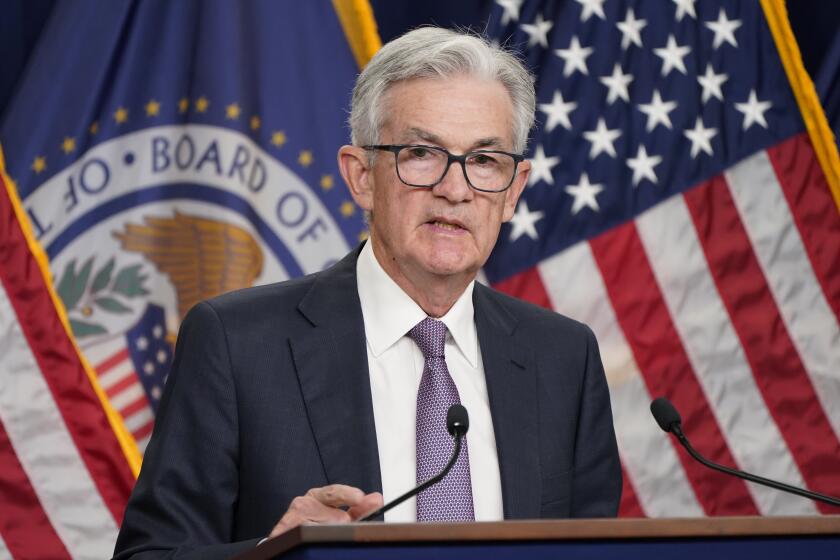Despite high-profile layoffs, most workers likely to keep jobs if recession comes

The global economy is stuttering, and some of the world’s biggest names are already laying off thousands of employees. But there’s a glimmer of good news: This time around, workers have a better-than-usual shot at holding on to their jobs if a recession arrives.
Almost three years after COVID-19 hit, companies around the world still complain that they can’t get the talent they need. They worry about labor shortages that probably will last beyond not just the pandemic, but also the next downturn too. Deeper forces, such as changes in population and immigration, are shrinking the pool of workers from which they can hire.
All of this means that despite weakening demand for their goods and services, many businesses are looking to retain or even add staff, rather than let them go — hoarding labor that they know they’ll need once the economy starts accelerating again.
There have been plenty of high-profile layoff announcements lately, from the likes of Amazon and Goldman Sachs. But they may prove to be outliers. That would make the coming economic slowdown very different, and in some ways less painful, than the ones the world has gotten used to.
Bloomberg Economics projects that unemployment will rise by about 3.3 million across developed economies by 2024, a period in which most are expected to suffer recessions. Although that’s a lot of lost jobs, it’s fewer than the 5.1 million shed in the relatively mild downturn that began in 2001, and is dwarfed by the scale of the last two global slumps.
This year has been hellish for several tech companies based in the Bay Area, especially in the last month.
What’s more, the starting point for employment is historically strong. The jobless rate in major developed economies, at 4.4% in September, is the lowest since the early 1980s, according to the Organization for Economic Cooperation and Development.
This time around, white-collar industries including business services, tech, banking, and real estate, in which staffing numbers are far above pre-COVID-19 levels and layoffs have already begun, may be more vulnerable to job cuts.
From his perch as chief executive of ManpowerGroup, a global staffing agency, Jonas Prising expects to see companies trying to keep employees on their books even as business slows down.
“They’ll absorb a drop in demand for their products and services but maintain their work forces,” he says. “They’re not going to be hiring. But I think we can expect payrolls to stay healthy.”
In the U.S., at least, that’s the message central bankers are hearing as they try to bring down sky-high inflation and reduce demand in the economy and the labor market without causing a recession.
Since the Fed met earlier this month, economic data have shown moderate growth with some signs of slowing inflation amid a still strong labor market.
“Business contacts are telling us that they plan to keep workers even as the economy slows because it was just so difficult to attract them and retain them over the last few years,” Loretta Mester, president of the Cleveland Federal Reserve Bank, said Nov. 10. “That would be a good thing in the sense that the unemployment rate would not have to go up as much.”
The Fed will get the latest snapshot of how much progress it’s making on Friday when the government releases its payroll report for November. Economists surveyed by Bloomberg predict an increase of 200,000 jobs.
In the United Kingdom — which is already in recession, according to most economists and the government — more than half a million jobs are forecast to go in the next two years. However, that would merely raise the unemployment rate to 4.9%.
Even as the government’s fiscal watchdog issued its warning forecast Nov. 16, industry leaders were grappling with staff shortages in sectors such as hospitality and retail.
“We all know that every business is facing additional costs because labor is so much tighter,” said Sharon White, chair of the John Lewis Partnership. “I think there’s a much bigger conversation about the labor market and jobs and how we attract people back into work.”
As for the euro area, joblessness is at an all-time low in the history of the single currency. Even with a recession probably underway, official European Union forecasts released at the end of October show employment growth continuing through 2024 — albeit with a significant 2023 slowdown — and joblessness rising only moderately.
Officials attribute that to government measures supporting job retention, along with aging populations. Plausibly, greater protection for European employees constraining staff cuts by companies might also help.
The world’s worst public health crisis in a century certainly disrupted labor flows, leaving countries such as Australia seeking to boost immigration. And it shrunk the workforce, with labor market participation in the U.S. and U.K. still below pre-pandemic levels.
New Zealand is among the economies feeling a hit. Central bank Gov. Adrian Orr said the shortage of workers means it’s all about “labor labor labor.”
“It’s an incredibly competitive market,” Orr told reporters Wednesday after raising interest rates by a record 75 basis points. “The churn in the labor market is incredibly high. There’s huge competition in the market.”
The COVID-19 pandemic not only claimed more than 6 million lives, but also has left millions more saddled with long COVID or other disabilities that make them unable to work. Many people also opted to take early retirement, tend to their families or get better educated.
That pandemic-driven contraction in the labor pool came on top of a longer-term structural trend toward tighter jobs markets as the huge baby boomer generation retires and leaves the workforce.
Without measures such as sustained immigration, aging populations will shrink work forces in many countries, according to a recent study of labor markets in the U.S., Canada, France, U.K., Germany, Australia, Japan and China by Glassdoor Inc. and Indeed Inc.
That’s pushing some companies and governments to think longer-term.
“We have to make sure we manage through downturns in such a way that we’re in a good place to handle the upturns,” Cynthia M. Sanborn, chief operating officer of Norfolk Southern Corp., told Wall Street analysts Oct. 26. “So we have levers such as attrition that can help us if we need it, but we also know that we have to be fortified in having a good hiring pipeline or a line-of-sight to that hiring pipeline, so that we can manage the upturn.”
Labor shortages are most acute in some of the industries hardest hit by the pandemic.
Payrolls in the U.S. leisure and hospitality industry are more than 1 million below where they were prior to the COVID-19 shock. Restaurant staffing is also lower as well.
That’s got economists such as Betsey Stevenson of the University of Michigan thinking that layoffs in those sectors won’t be nearly as large as they have been in previous downturns.
White-collar workers may not fare as well — as a string of recent high-profile layoff announcements suggest. Elon Musk made deep cuts at Twitter, and Meta CEO Mark Zuckerberg is letting 11,000 employees go. Amazon will shed a similar number of staff into 2023, while HP will eliminate as many as 6,000 roles over the next three years.
All told, the tech industry announced 9,587 job cuts in the U.S. in October, the highest monthly total since November 2020, according to Challenger, Gray & Christmas, a consulting firm.
In banking, a sharp downturn in revenue from deal-making and debt issuance has put investment bankers on high alert. Goldman Sachs is embarking on its biggest round of layoffs since the start of the pandemic, with plans to eliminate several hundred roles. Citigroup cut dozens of positions in early November, while reductions expected to eventually total about 200 have begun at London-based Barclays, according to people familiar with those moves.
The cuts in tech and finance may be dramatic, but no one is expecting a massive wave of layoffs, as happened in 2008. Tech also represents only about 2% of all employment in the U.S., according to ADP Research Institute.
What’s more, many of the information technology workers getting pink slips at bigger companies may end up being hired by smaller firms that have had difficulty attracting such talent, said Tom Gimbel, CEO of Chicago-based employment agency LaSalle Network.
“The great news for small and medium-sized companies is that they don’t have to pay the same outrageous salaries the big companies were paying,” he said.
The pandemic’s aftermath also has made it tougher for companies to hold on to their workers, with employees seemingly more willing than in the past to look for better opportunities elsewhere.
One in 5 U.S. workers ages 25 to 54 reported actively applying for new positions last month, according to the latest high-frequency data from decision intelligence company Morning Consult.
“There is a great talent reshuffle happening across the world,” LinkedIn CEO Ryan Roslansky told Bloomberg Television. “People are trying to find new jobs and opportunities and upskill.”
Although Fed officials appear poised to begin slowing the pace of interest rate hikes, all bets will be off if inflation persists. That’s especially so if confident workers seek higher wages, fueling price rises. Resulting rate increases from the Fed and other central banks could drive their economies into deep downturns, and companies probably would resort to big layoffs as their profits dwindled.
But as in the U.S., jobs are holding up in many economies that have aggressively raised rates. New Zealand’s unemployment rate remains near a record low while wages rose by the most since the series began. Australia has been forced to loosen migration requirements to allow as many as 35,000 more workers to enter the country every year.
“The great ‘reopening’ has stoked demand for workers in the services sector, above all hospitality, while manufacturers are still scrambling for workers to catch up with their order backlogs,” said Frederic Neumann, chief Asia economist at HSBC Holdings.
“Employers left short of staff over the past year are also likely to be reluctant to trim their payrolls aggressively, fearing that they may struggle to rehire once growth recovers,” Neumann said.
“Labor markets, in other words, may prove far more resilient in this cycle than in the past, leading central bankers little room to turn accommodative once growth begins to wobble.”
— Tom Metcalf, Myriam Balezou, Andrew Atkinson, Vince Golle, Sabah Meddings and Craig Stirling contributed to this report.
More to Read
Inside the business of entertainment
The Wide Shot brings you news, analysis and insights on everything from streaming wars to production — and what it all means for the future.
You may occasionally receive promotional content from the Los Angeles Times.












